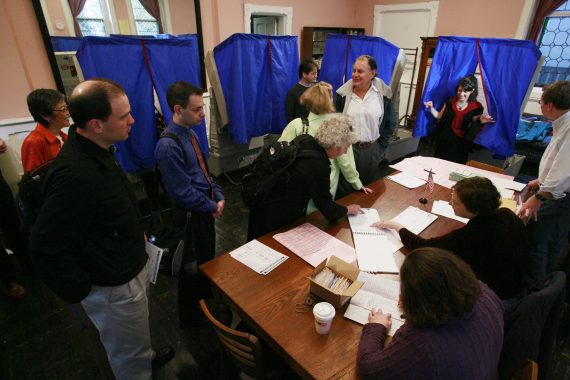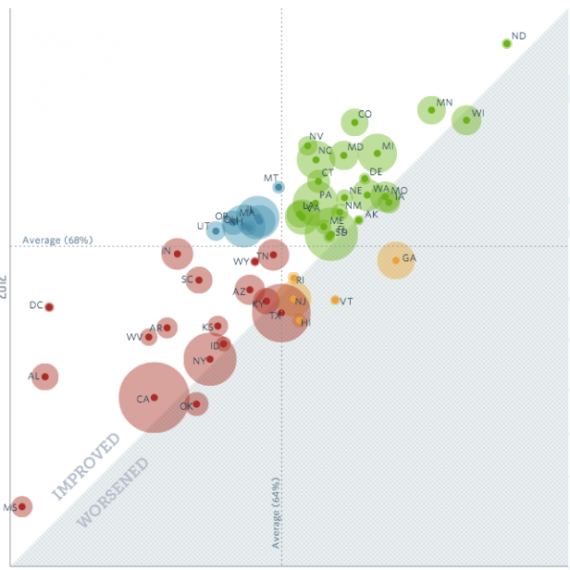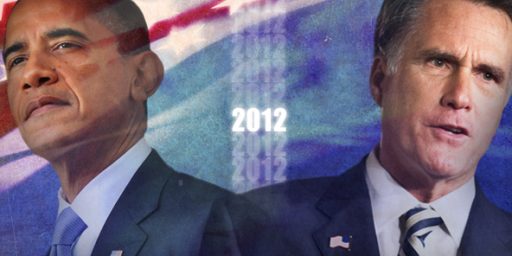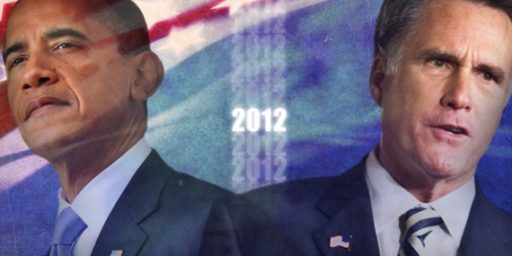Which State Has The Worst Elections?
A new study ranks the 50 states based upon how well their election system functions:
How did each state’s election apparatus perform in the 2012 election? Better than 2008 but still not all that well, according to the annual study, conducted by the Pew Charitable Trusts, of state-by-state elections.
“Overall, 40 states and the District improved their scores in the 2012 election, compared with 2008,” reads the report. “The scores of 21 states and the District rose at a rate greater than the national average, 19 states’ averages improved but didn’t keep pace with the national average, and 10 states’ performance declined. The District improved the most — 20 points — from 2008 to 2012 but still remained among the lower performers.”
(…)
North Dakota is the shining star of election performance, with an 86 percent score in 2012 and an 84 percent score in 2008. Mississippi brings up the rear again with a 44 percent score in 2012 and a 40 percent rating in 2008. Alabama was the only other state to come close to Mississippi’s poor performance with a 56 percent score in 2012 — although the the Yellowhammer State deserves some credit since its score was a lowly 42 percent in 2008.
Of the 22 states whose EPI score ranked below the national average in 2012, 16 were carried by Mitt Romney in 2012. Of the 17 states whose EPI was below the national average in 2008 and 2012, 16 were carried by Romney in the last presidential election. (California was the lone two-time low performer won by President Obama.)
Perhaps most problematic is the fact that the most populous states seem to fall so far down the list as this chart demonstrates. The larger the circle, the larger the states population:
Nearly all of the states with large populations fell below the national average, and many of them saw their performance worsen in 2012 as compared to 2012. Given the fact that we are supposedly one of the most advanced nations on the planet, the fact that we seem to have so much trouble conducting elections, and show so little willingness to fix what is so obviously broken, is really quite frustrating.








One of the big “indicators” they use is turnout. I’m not sure I buy that as a statistically valid measure of how good a state’s election system is.
100% vote by mail like we have in Oregon and Washington is the answer. We have some of the highest voter participation in the US.
Who knows what the causations are? I wonder what the coorelations with education or literacy are.
@Ron Beasley: How does that work ? I am curious as to how they would know who actually filled out the ballot. I can imagine what might happen in our home – the kids or their friends might get hold of it and fill it out.
I wonder what their criteria was for making these judgements. One important thing to me and many others is how long they have to wait in line. Other things that are important: free coffee and snacks, restrooms close by, and big screen tvs showing movies, like “Spider Man” and “Star Trek”. It would also be nice to have some chairs. And no, absolutely no, waiting outside in the rain, cold, or blazing heat. The church where I vote does have a nice booth outside that gives out free drinks and popcorn, and sells hot dogs. Now that is a great polling place. The turnout percentage is always very high. That is why I would rather vote there than mail in the ballot.
“Getting there is half the fun”
What I find bizarre is a country where all elections are organized at county and state level.
Andre:
But having counties and states involved in elections makes sense. Historically, local issues have been as important to voters as national issues and candidates — think of California’s “Proposition 8” as an example. On a typical ballot today in this state, there are state constitutional issues, school board elections, bond issues, local tax initiatives, votes for community college trustees and judges and innumerable state officials, etc. The lists of candiates for President and Congressmen rarely takes more 3 pages of a 10-12 page ballot.
One issue I think is method of voting.
Some methods just move a line faster than others.
I live in a small town and up until just before the 2008 elections we used paper ballots that were counted by hand. Then they got the optical scan type.
Optical scan is fast though-once you have the ballot there are about 20 booths to fill it out in (we don’t need 20 and a city could have more). I have never had to wait in line more than a few minutes.